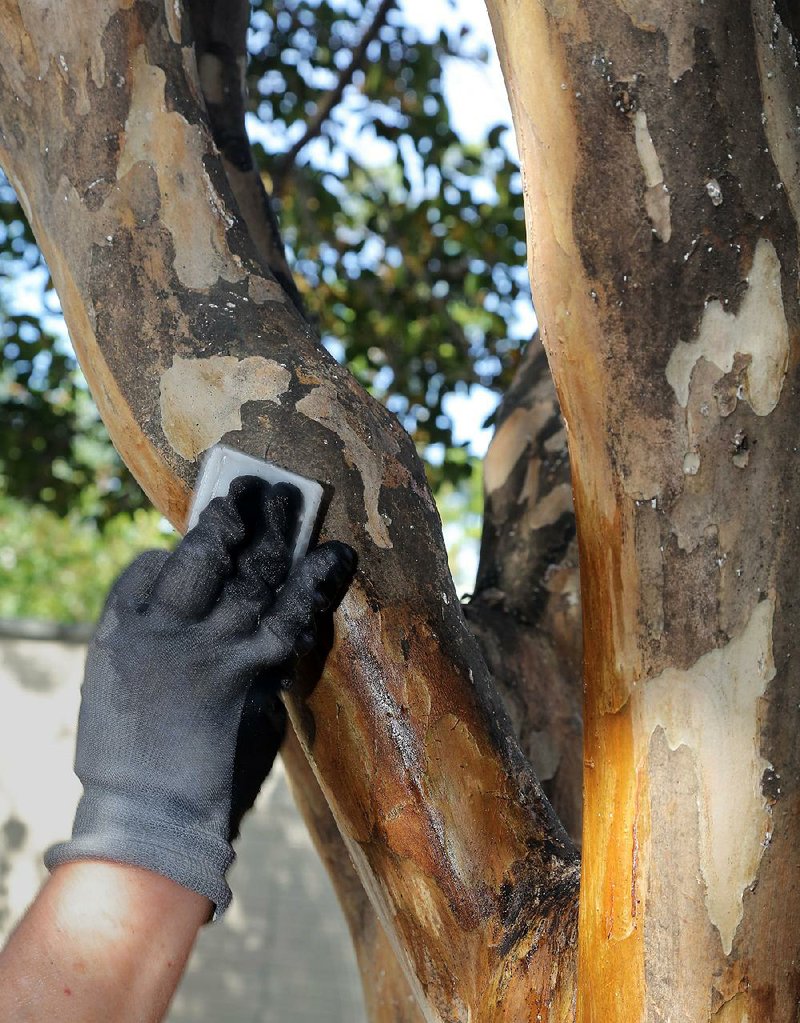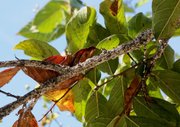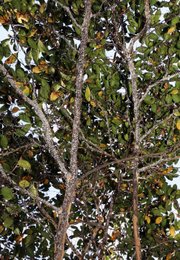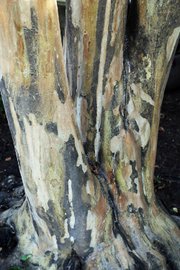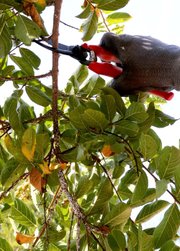The crape myrtle has been considered a bulletproof plant in the South, being drought-tolerant and seemingly indestructible. But a new insect pest has emerged that threatens this staple of the Arkansas landscape.
If pruned properly, these trees bloom freely all summer, have beautiful fall foliage and, in winter, have outstanding bark. Winter damage can take a toll, as it has during the past two years, but plants rebound to bloom nicely, albeit a tad late this season.
The new threat, crape myrtle bark scale, was spotted in Arkansas two years ago. The University of Arkansas Cooperative Extension Service has received more and more reports about the invasive insect attacking crape myrtles from central Arkansas southward.
Crape myrtle bark scale was first noticed in a north Dallas suburb in 2004. It spread quickly across the South and has begun to reach northward. In October 2013, the insect was confirmed in Germantown, Tenn. It showed up in Little Rock in January 2014. Since then, we have found cases from Pulaski County southward to Miller County, including a recent rash of discoveries.
WARNING SIGNS
Many gardeners' first warning that the insect has beset their yards is when they notice a black mold on the stems or trunks of their plants.
This black substance is called sooty mold and is a byproduct of sucking insects, including scale and aphids. As these insects feed, they excrete a sweet substance called honeydew. Wherever this honeydew lands, black sooty mold will form.
Aphids also can be a problem on crape myrtles at the end of summer, but they are not cause for much concern. But if sooty mold is accompanied by white specks on the trunks or branches, the tree has crape myrtle bark scale and that is cause for concern.
WHITE BLOBS
Since the insect is relatively new, we don't have extensive data to tell us if one variety of crape myrtle is more susceptible than another, or if there are certain conditions that make it more of an issue.
In early stages of infestation, the female insects appear as white or gray feltlike growths on small twigs to large trunks, often showing up near pruning wounds or, on older parts of the tree, in branch crotches. If undetected, the spread can become fairly extensive. Heavy infestation will result in white-crusted clusters of insects, which may blanket small stems and be very visible on the trunks.
If you get up close or use a magnifying glass, you will see that under the crusty covering is an adult insect, which can be white to gray. There may be dozens of pink eggs or crawlers under some of the larger white scale covers.
The covering is composed of white threads produced by the female that become felted or matted into a thick whitish scale over her entire body. The adult female under this covering is attached to the cover and unable to move. She continues to feed by sucking sap out of the tree and lays eggs under the covering, after which she dies.
In a normal season, egg laying should occur in late April to mid-May. With our unusual winter and cool spring, this could have been delayed some this year.
When the eggs hatch, the small nymphs have legs and are mobile; they are called crawlers. These crawlers emerge from under the "mother scale" and begin to move about the branch. Females find their new location on the tree, exude their white cover, become attached and start the process all over. Males develop wings, find a female, mate and then die.
The number of generations this insect is able to create in a year is unknown, but experts suspect that there may be at least two generations in Arkansas.
TAKE ACTION
Scale insects will not kill a tree in one season, but they can weaken it to the point where it won't bloom as freely. Long-term effects are not known, since this scale is a new pest. But if you spot it on your tree, you should do something about it.
If you have small limbs that are heavily infested, prune them off and dispose of them. Do not put them in a compost pile or set them out on the curb for yard-waste pickup.
Instead, double-bag the cuttings and put them in your regular trash pickup.
(Controlling this insect in the city would be a bit easier if all homeowners could simply burn the debris and eradicate the pest, but unfortunately we can't burn refuse in the cities.)
If infested wood is hauled around in an open truck or left on the curb, potentially millions of tiny crawlers and winged males could find their way to neighboring properties, thus accelerating the spread of this invasive insect.
SCRUB THE TREES
If you find scale insects on the main trunk of the tree, use a soft brush with soapy water to clean the trunk. This will get crawlers off, and also remove the black sooty mold.
Once all the leaves have fallen off the tree later this fall or in early winter, spray the entire tree thoroughly with a dormant oil, saturating the trunk and stems.
As crape myrtles age, they have peeling bark. This peeling bark is attractive but also can harbor overwintering insects, which may not be smothered by the oil. So pay particular attention to these areas when spraying.
In the spring as the tree begins to fully leaf out, use a soil drench with a systemic insecticide such as Imidacloprid (Merit or Bayer Advanced Tree and Shrub Insect Control), thiamethoxam (Meridian) or dinotefuran (Greenlight Tree and Shrub Insect Control With Safari). These products will be taken up by the roots and moved throughout the tree, and have shown good results in controlling this scale.
Be aware that once the insects die, they will remain attached to the plant but will no longer cause damage and will not spread.
Currently we don't believe that a properly applied soil insecticide (following label directions) will do any significant damage to foraging pollinators, such as bees. But we are continuing to research this situation.
Only treat a tree that has the insect problem -- don't spray preventively.
Researchers are also continuing to look for less susceptible varieties of crape myrtle and safer, less expensive treatments for this scale insect.
Crape myrtles will continue to be a recommended plant for the South and horticulturists hope that, in time, we will eradicate this new crape myrtle bark scale or else find resistant varieties of crape myrtle.
Until that time, monitor the crape myrtles in your yard, treat the trees if you find scale insects and if you need more information, contact your local county extension office. The extension service has a free fact sheet about crape myrtle bark scale at uaex.edu; search for "fsa-7086."
HomeStyle on 09/19/2015
